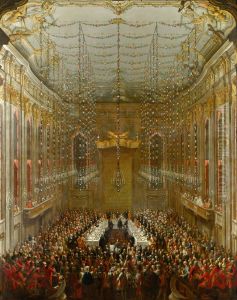Martin Van Meytens Paintings
Martin Van Meytens, also known as Martin Meytens the Younger, was an eminent Swedish-Austrian portrait painter who gained significant recognition in the 18th century. Born on June 24, 1695, in Stockholm, Sweden, he was part of a family with a strong artistic background. His father, Martin Meytens the Elder, was a successful painter, and this environment undoubtedly influenced young Martin's future career.
Meytens began his artistic journey under the guidance of his father. He later moved throughout Europe to broaden his experience and hone his skills. His travels took him to Denmark and eventually to Vienna, where his career began to flourish. Meytens was particularly adept at capturing the likeness and character of his subjects, which made his work highly sought after among the nobility and the imperial court of the Habsburgs.
In Vienna, Meytens became an important figure at the court of Emperor Charles VI and later under Empress Maria Theresa. His style was characterized by elegance and a keen attention to detail, which was typical of the late Baroque period. He was adept at both oil painting and fresco, and his portraits were known for their clarity, realism, and sophisticated color palette.
Meytens' work often depicted the grandeur and the ceremonial aspects of the imperial court, and he was instrumental in documenting the faces and fashions of the Austrian nobility of the time. His portraits served not only as a reflection of the individuals but also as a means of reinforcing social and political hierarchies. He became the principal court painter, a position that provided him with both prestige and financial stability.
Throughout his career, Meytens trained numerous apprentices, spreading his influence across Europe. He became a member of the Vienna Academy of Arts, where he also served as a director, further cementing his status as a key figure in the European art scene of the era.
Meytens continued to work until his later years, leaving behind a vast and influential body of work when he passed away on March 23, 1770, in Vienna. His legacy persisted through his students and through the many court portraits that continue to give insight into the cultural and historical context of 18th-century European society. Today, Martin Van Meytens is remembered as one of the most prominent portraitists of his time, and his paintings can be found in museums and private collections around the world.


















